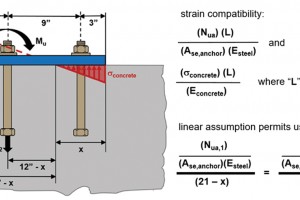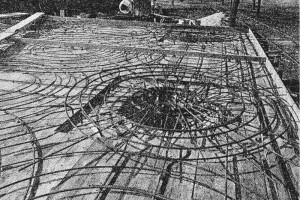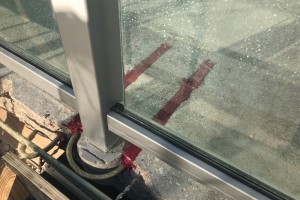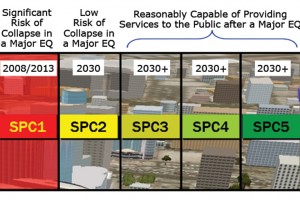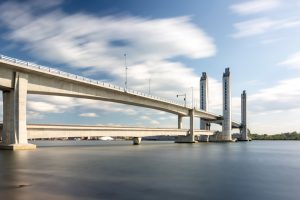Anchoring-to-concrete provisions in the American Concrete Institute’s Building Code Requirements for Structural Concrete (ACI 318) are used to calculate anchor design strengths that consider possible anchor failure modes. These design strengths are checked against calculated factored loads acting on anchors. ACI 318 anchoring-to-concrete parameters for calculating anchor design strengths are derived from testing and analysis that includes the use of a rigid fixture to apply tension load to anchors. Therefore, ACI 318 provisions for anchor design can be considered relevant if the fixture being attached can be considered “rigid.” …
Review Category : Articles
Part 2: SMI Concrete Flat Plate and Site Safety Demolition Plan Peer Review
This four-part series (Part 1, STRUCTURE, November 19) discusses how the collapse of a building during a demolition operation in Philadelphia in 2013, which resulted in several fatalities, led to the enactment of a City Ordinance to prevent similar future calamities. As a result of the Ordinance, the author became involved with the structural investigation, review of the Site Safety Demolition Plan, and Demolition Special Inspections associated with the adaptive reuse of the Apex Hosiery Company Building located in Philadelphia. …
I enjoy reading The Journal of Light Construction (JLC) to learn about expert techniques used on residential projects. In their June 2019 issue, I read two articles; Defining Efficiency Goals – A process for selling performance in new homes by Indigo Ruth-Davis and As Best I Can by Mark Luzio. The Ruth-Davis article addressed how to sell high performing environmental designs for homes in Vermont by providing alternative designs with estimated construction costs and annual energy costs. The Luzio article focused on providing quality construction and working with clients. Luzio describes always doing the best he could, noting that he and his best clients know that everything is not perfect (“a fool’s errand” to quote), but that his work was not a low bid job either. …
Design and detailing of handrail anchorages in concrete structures must consider both structural performance and susceptibility to corrosion. Without these dual considerations, handrail anchorages are more likely to fail. For decades, premature corrosion of handrail anchorage components was prevalent in the concrete industry. Deterioration of the anchor embedments due to galvanic corrosion, direct exposure of aluminum to concrete, or insufficient concrete cover resulted in costly repairs. …
The performance of existing buildings in earthquakes provides many lessons. Most of them – building system specific – have been very eloquently articulated in the preceding articles published in STRUCTURE (Northridge – 25 Years Later series). However, as the discussion about creating resilient communities continues, other lessons learned are factors to consider before drafting policies intended to reduce the risks associated with Natural Hazard Events (NHE). …
Why It’s Catching On and What You Need to Know
“The original idea of the web was that it should be a collaborative space where you can communicate through sharing information.” –Tim Berners Lee, inventor of the world wide web
Today, cloud-based modeling for construction is an example of Lee’s original thought. Companies employing these methods are reaping real, recognizable benefits from cloud-based modeling. The technology required to support cloud-based modeling can be challenging to sift through, but understanding and harnessing its power can pay off in both time savings and productivity increases. …
STEM jobs (Science, Technology, Engineering, and Math) are on the rise, and STEM degree programs and graduates are on the rise too. So, why are Structural Engineers so hard to find, particularly mid-level engineers with a few years of experience? Several reasons are essential to understand if we are going to create strategies to find and attract that elusive talent. …
Between Kittery, Maine and Portsmouth, New Hampshire
The new Sarah Mildred Long Bridge carries the US Route 1 Bypass and a heavy rail line that serves the Portsmouth Naval Shipyard over the Piscataqua River. Coined “three bridges in one,” the crossing consists of vehicular approach bridges stacked over railroad approach bridges leading to a vertical lift span over the navigation channel. The moveable span lifts from the normal roadway position to allow passage of tall vessels underneath and lowers to railroad track level, allowing trains to pass on the rail in the roadway median of the lift span. With a 56-foot vertical clearance in the “resting” position at the vehicular level, there are 68% fewer bridge openings compared to the previous bridge. …
Challenges and Opportunities for Structural Engineers
Architecture 2030 (architecture2030.org) reports that, between now and 2060, growth in the world’s population will require a doubling in the amount of building floor-space, equivalent to building an entire New York City every month for 40 years. Much of the carbon footprint of these new buildings will take the form of embodied carbon – the carbon emissions associated with building construction, including extracting, transporting, and manufacturing materials. As a result, owners, designers, engineers, and contractors are turning their attention to building materials and seeking information on these products so they can make more environmentally informed and smarter choices. …
“Choose a job you love, and you will never have to work a day in your life,” Confucius (supposedly) once said. If this is true, I have not worked in more than 40 years. Yes, I am one of those unbelievably lucky people who love what they do. Where I am today is because of a thousand little things that happened to me along the way, most of them positive, some of them negative, but all of them meaningful to me. These experiences have made me look at myself and my career from a different perspective than I think I would have had they not occurred. …

